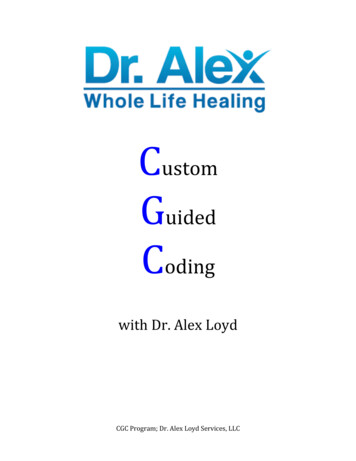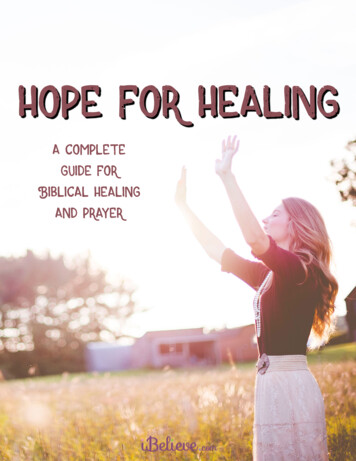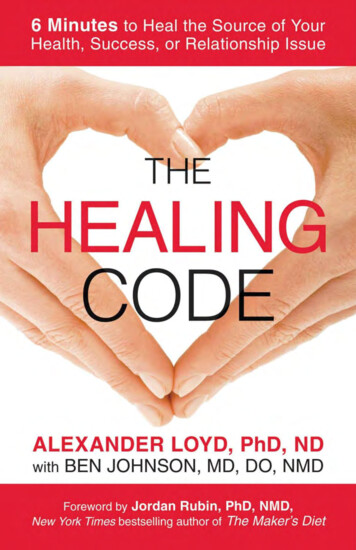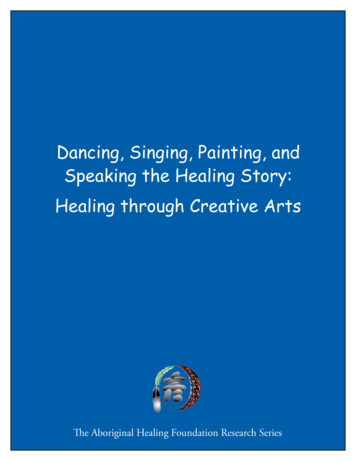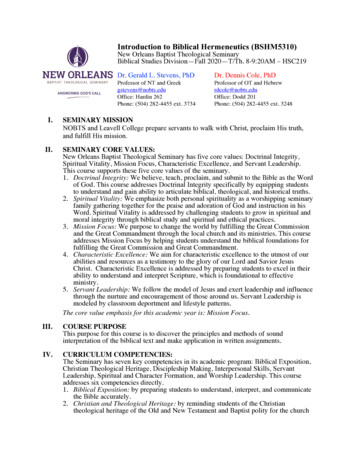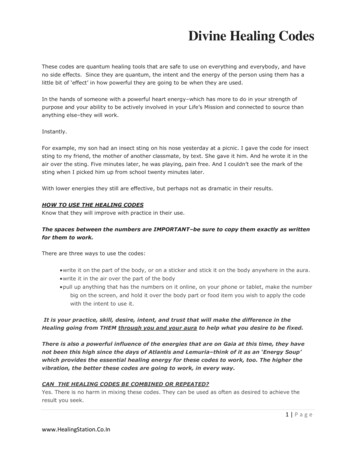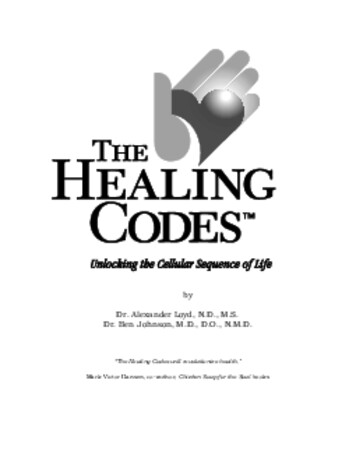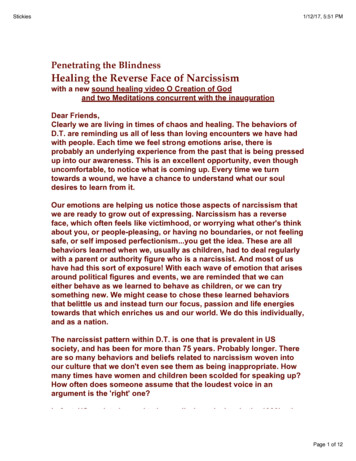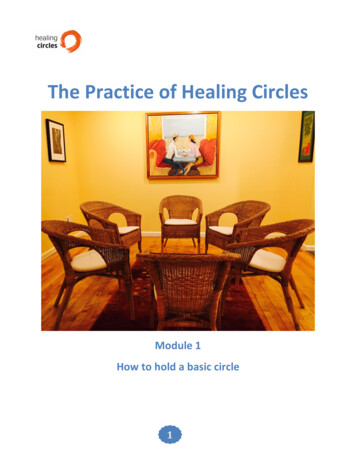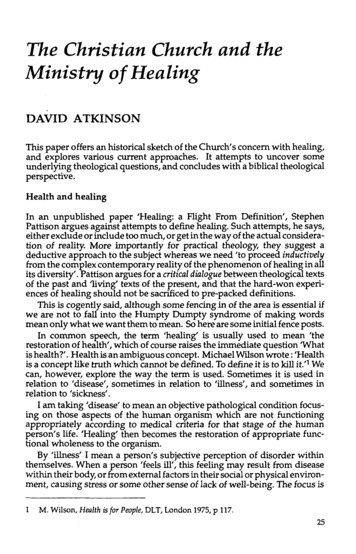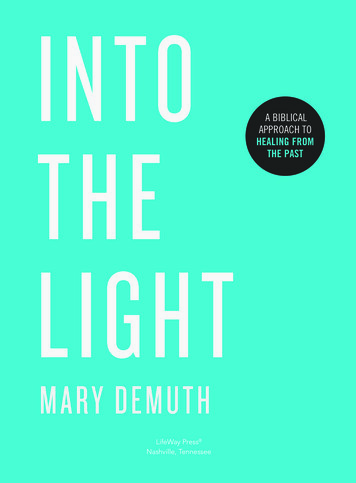
Transcription
A BIBLICALAPPROACH TOHEALING FROMTHE PASTLifeWay Press Nashville, Tennessee
Published by LifeWay Press 2020 Mary DeMuthNo part of this book may be reproduced or transmittedin any form or by any means, electronic or mechanical,including photocopying and recording, or by anyinformation storage or retrieval system, except as may beexpressly permitted in writing by the publisher. Requestsfor permission should be addressed in writing to LifeWayPress ; One LifeWay Plaza; Nashville, TN 37234.ISBN: 978-1-0877-0594-1Item: 005824845Dewey decimal classification: 158Subject heading: HEALING / HELPING BEHAVIOR / PEERCOUNSELING / WOMEN IN THE BIBLEUnless otherwise indicated, all Scripture quotationsare taken from the Holy Bible, New Living Translation,copyright 1996, 2004, 2015 by Tyndale HouseFoundation. Used by permission of Tyndale HousePublishers, Inc., Carol Stream, Illinois 60188. All rightsreserved. Scripture quotations marked (ESV) are from theESV Bible (The Holy Bible, English Standard Version ).ESV Text Edition: 2016. Copyright 2001 by Crossway,a publishing ministry of Good News Publishers. TheESV text has been reproduced in cooperation with andby permission of Good News Publishers. Unauthorizedreproduction of this publication is prohibited. All rightsreserved. Scripture quotations marked (NASB) are fromthe NEW AMERICAN STANDARD BIBLE , Copyright 1960,1962,1963,1968,1971,1972,1973,1975,1977,1995 byThe Lockman Foundation. Used by permission. Scripturequotations marked (NIV) are from THE HOLY BIBLE, NEWINTERNATIONAL VERSION , NIV Copyright 1973,1978, 1984, 2011 by Biblica, Inc. Used by permission. Allrights reserved worldwide.To order additional copies of this resource, write LifeWayChurch Resources Customer Service; One LifeWay Plaza;Nashville, TN 37234; Fax order to 615.251.5933; call tollfree 800.458.2772; email orderentry@lifeway.com; or orderonline at www.lifeway.com.Printed in the United States of AmericaAdult Ministry Publishing,LifeWay Church Resources,One LifeWay Plaza,Nashville, TN 37234EDITORIAL TEAM,ADULT MINISTRYPUBLISHINGBecky LoydDirector, Adult MinistryMichelle HicksManager, Adult MinistryShort Term Bible StudiesElizabeth HyndmanContent EditorErin FranklinProduction EditorLauren ErvinGraphic DesignerMicah KandrosCover Design
CONTENTSABOUT THE AUTHOR5INTRODUCTION6SESSION ONE: Biblical Foundations of Loving the Broken8SESSION TWO: The Anatomy of the Healing Journey44SESSION THREE: Trauma76SESSION FOUR: Safe Churches104SESSION FIVE: A Kingdom Perspective130SESSION SIX: A Way Forward158SESSION SEVEN: The Superpower of Weakness184LEADER GUIDE186ENDNOTES191
4
ABOUT THE AUTHORMARY DEMUTHIf you met Mary DeMuth today, her joy might confuseyou. Whom she has become in light of tragedy isa testimony of Jesus’ ability to transform a brokenlife. Mary was a child of three divorces, a victimof repeated sexual assault at five years old, anda daughter of a father who died when she was ten.Mary wanted to end her life in her teens. In the tenthgrade, she heard about Jesus, and she knew shewanted to chase after Him for the rest of her life.Thankfully, He chased her.Mary is the author of forty books, including the bookthis study is based on: We Too: How the ChurchCan Respond Redemptively to the Sexual AbuseCrisis. She has spoken around the world about God’sability to transform a life, bringing needed freedomto her audiences. She’s the host of the popular dailypodcast Pray Every Day, and she’s been on CNN andfeatured in The Washington Post, Christianity Today,and The New York Times. She’s spoken around theworld in places like Munich, Johannesburg, Port-auPrince, Geneva, and Monte Carlo, and she’s planteda church with her family in southern France.Her best work? Being a mom to three amazingyoung adults and the wife of twenty-nine years toPatrick. She makes her home in Dallas alongside herhusband, an energetic chocolate lab, and a fuzzyblack cat. Find out more at MaryDeMuth.com orWeToo.org. 5
INTRODUCTIONWelcome! I am proud of you. I applaud your bravery and compassion as you pickup this study. You are someone who deeply cares about the people in your life, andyou understand that the God of compassion has empowered you to be empathetictoward those who are broken and walking wounded. You intrinsically understandthat you, along with your brothers and sisters around the world, are the handsand feet of Jesus to those who are scattered without shepherds, who feel lost andutterly alone.Perhaps you have felt that way too.The overarching goal of this study, based on my book, We Too: How the ChurchCan Respond Redemptively to the Sexual Abuse Crisis, is for us to learn howto become both a good shepherd and a good Samaritan. Our time together willnot specifically deal with that type of traumatic situation; instead, this study isbroadened to anyone who has suffered. My prayer is we can learn how to helpall the people in our lives, particularly those who are walking through struggle ortrauma.The prophet Ezekiel detailed the chastisement God had for the nation of Israel, whofailed to not only proclaim God as good and in want of a relationship with the wholewide world, but also failed by treating others with unkind harshness. Consider thesecautionary words in Ezekiel 34:4-6:You have not taken care of the weak. You have not tended the sickor bound up the injured. You have not gone looking for those whohave wandered away and are lost. Instead, you have ruled them withharshness and cruelty. So my sheep have been scattered withouta shepherd, and they are easy prey for any wild animal. They havewandered through all the mountains and all the hills, across the face ofthe earth, yet no one has gone to search for them.What a picture of the broken today. We are a world of wanderers, untethered.Technology has simultaneously “connected” us to people all over the world whilereminding us of the difficult truth: We are lonely and often alone. In isolation,predatory people prey. And in the aftermath of that preying, refugees of sadnessare in desperate need of our prayers.People need to be searched for. They bear the image of their Creator. Becauseof this, they are worthy of pursuit. And yet so many have struggled. They have6
battled family structures that neglected or perpetrated against them. They haveexperienced betrayal, abandonment, and contempt. And some of those injuriesoccurred within the four walls of the church. They long for genuine community, buttheir hearts are fearful. Their trust muscle has atrophied.We can be the answer to their prayers.Not by our strength. Not by our wits. Not by our cleverness. But by His beautiful,wooing Spirit.This study is for them, but it is so much for you too. In order to pursue and refreshothers, you must first put yourself under the spigot of God’s grace. You must sit, asMary of Bethany did, in the position of the Rabbi’s disciple—at the feet of Jesus(Luke 10:39). In this place of discipleship and encouragement, you will be pouredinto. And from that well of overabundance, you will be able to help those who hurt.Proverbs 11:25 reminds us, “The generous will prosper; those who refresh others willthemselves be refreshed.”That is my prayer for you as you work through the next seven sessions.Please note this study is not intended to be legal counsel or to provide holisticcounseling or pastoral care on the issue of abuse. The study gives a theologicalfoundation for healing, brings understanding on the issues connected to abuse,and gives practical wisdom by which women can navigate complex situations. 7
SESSION ONEBIBLICALFOUNDATIONSOF LOVINGTHE BROKEN8
You don’t have to venture far from yourphone or the screens in your life tofind pain. It’s everywhere. Trauma haspermeated our feeds on a micro andmacro scale. Everywhere, people aresuffering. It’s overwhelming, and it’spervasive. And because of the fall ofhumankind, it’s (sadly) to be expected.When I turn through the pages of theBible, I see a similar chaos. Violence,predation, annihilation of peoplegroups, crucifixion, betrayal, strifewithin families, double crossing, war,famine, poverty, prejudice, wrath—allthis within the pages of the sacred text.These are not the passages we post onInstagram, but they are instructive. TheLord meant for the story of Job to bein the Bible, after all. Why? Because inthis world we will suffer.The entire narrative of the Bible isthe story of a God who relentlesslypursues His people, despite theirinfidelity, waywardness, and penchantfor worshipping idols and themselves.It is a divine rescue mission,inaugurated in God’s mind, whereHe would dare leave the beauty ofheaven to pitch a tent with humanity.And as He did, Jesus taught us howto love each other. He showed uswhat sacrifice looked like. He soughtout the least, the last, and the lostbecause it flowed from His nature.9
The life, death, and resurrection of Jesus are our coursework. How Heencountered everyday people like you and me is wholly and beautifullyinstructive. Not only that, but the gospel is clear: Jesus not only loved us, butHe fully carried out the rescue mission of the Father. He bore the weight of everyone of our sins on the cross, an innocent One dying for the guilty, His bloodpouring from a crowned brow of thorns. He did this for me. He did this for you.Because of love and justice.The resurrection proved His promises, divine nature, and rescue mission. Godmet humanity, conquered death, and ushered in a brand-new kingdom, this ageof grace we live in today.This is the place we find ourselves, balancing like a teeter-totter between the nowand the not yet. Now, we are kingdom workers seeking to love God and serveothers as we bumble through life. Now, we long to see people experience thevery real redemption of Jesus. Now, we are still encumbered by sin, and we haveto grapple with the sad reality that people can act inhumanely toward others—yes, even in the church, yes, even when the person is a leader in the church. Now,we encounter seemingly senseless suffering as a result of our world’s brokenness.This should not be, but it is our reality. All this confusion, cover up, and pain willbe vanquished gloriously on the other side, but now? We must learn what itmeans to live in this current world.Jesus put it simply: “The most important commandment is this: ‘Listen, O Israel!The Lord our God is the one and only Lord. And you must love the Lord yourGod with all your heart, all your soul, all your mind, and all your strength.’The second is equally important: ‘Love your neighbor as yourself.’ No othercommandment is greater than these” (Mark 12:29-31).Love God. Love others.My hope for this week’s study is that you will have a firm foundation as well asa theological construct from which to build a life that passionately loves Jesusand wisely loves those Jesus has brought into your life.10IN TO TH E LIG H T
Mind if I pray for you?Lord Jesus, would You open our eyes to Your hope for us? We need You as welook at those who are hurting. We need to understand You in the midst of thepain narrative. Help us to uncover Your empathy and make it our own, as we lovethose You have placed in our pathway. Reveal truth. Speak life. Renew our heartslike the dawn. Amen.B iblical F oundations of lo v ing the Broken11
WATCHVIEWER GUIDESESSION ONEIntroduce yourself to the people in your group. What drew you tothis study?How did Mary’s story encourage you? How did it help you see yourown pain or someone else’s pain in a different light?Describe a time when you needed the empathy of another.What do you think it means that “an untold story never heals”? Howhave you seen healing in your own life or in the life of others when theirstories come into the light?What do you hope to gain from this study?12IN TO TH E LIG H T#IntoTheLightStudyTeaching sessions available for purchaseor rent at LifeWay.com/IntoTheLight
NOTESB iblical F oundations of lo v ing the Broken13
DAY ONETHE ONE WHO NAMES GODWhen others are hurt, we naturally want to respond well. But often we don’t knowwhat to do or how to love them through their ordeals. During this first week ofstudy, I want us to look at several passages of Scripture to demonstrate how theBible provides a foundation as we learn to heal and help others heal from trauma.Throughout the Bible, we see people grappling with suffering, whether physical,mental, emotional, or even social. The Bible is full of narratives, but justbecause a story exists within its pages does not mean the Bible promotes thebehavior in the story. In other words, when we see a narrative of rape, the Bible’sdescription of what happened is not a prescription of its permissibility, but simplya description of how a fallen people deal with trauma.The Bible is not simply a manual of rules—to reduce it to that negates its majesty.The Word of God provides us with an abundance of stories that teach us how tonavigate our world. In short, we are wired for stories. As we search the Scriptures,one of the most stunning revelations we experience is uncovering the greatStory: When sin entered the world, God already had a proactive plan, one ofredemption for all of us.To be redeemed is to be bought back. Held hostage by sin, humankindcannot secure redemption, but God can and did through the life, death, andresurrection of Jesus Christ. This story informs our stories, even the ones thatinvolve suffering. The beauty of the gospel is that it represents God’s deepcompassion for us all.We see hints of the grand narrative of redemption throughout the Bible. Today,I want us to look at an unlikely heroine, Hagar.Hagar represents so many who have been hurt by circumstances, God’s people,and life. She was Sarai’s maidservant, a pawn in Sarai’s ploy to produce thepromised offspring through conniving means. However, the moment Hagarbecame pregnant, Sarai despised her ability to conceive and began to mistreather. After that, Hagar had two encounters with God that indelibly marked her.How God tenderly protected this maligned outcast is helpful to us as we seek tounderstand the heart and mind of a hurting person, as well as the compassionatehesed (loyal, covenantal love) of God toward His people. 114IN TO TH E LIG H T
Read Genesis 15:1-6.What did God promise to Abram? How did Abram respond?Read Genesis 16:1-3.What do we learn in these verses about Hagar? What plan did Saraicome up with as a solution? Why do you think she came up with thatplan?Did Hagar have a choice in the matter, from what we can tell fromScripture?Read Genesis 16:4-6.In your own words, what happened next in Hagar’s story?Hagar then fled to the wilderness. The New Living Translation says, “The angel ofthe Lord found Hagar ” (v. 7a). The angel asked her where she came from andwhere she was going. Hagar confessed she ran away. The angel told her to returnto her mistress, and he made her a promise.What did the angel promise in verse 10?The angel told her to name her son Ishmael. What does his name mean?B iblical F oundations of lo v ing the Broken15
Finish reading Genesis 16. What name did Hagar call the Lord?What struck you as you read this biography of Hagar?Hagar’s name means “fleeing” or “flight” or “to flee.” 2 We see Hagar live up toher name in two biblical accounts.Why do you think Hagar began to treat Sarai with contempt?Sarai blamed Abram for her problems. What does this teach us abouttheir relationship? About Sarai’s relationship with God?We have heard the phrase, “Hurt people hurt people,” and in this case, it appearsto ring true. Sarai most likely carried the grief of barrenness a long time. Fordecades, she lived with the scorn of not being able to conceive. Being unable toconceive was considered blight from the Almighty, a judgment against someone.Without an heir, Sarai felt worthless. All that pain bottled up for so long could nothelp but seep out of her.When has your grief seeped out onto another person?Have you encountered someone who exemplified the phrase, “Hurtpeople hurt people”? What stuck with you from that encounter?16IN TO TH E LIG H T
In this passage, Hagar ran into the angel of the Lord, who asked, “Hagar, Sarai’sservant, where have you come from, and where are you going?” (v. 8a). Thequestion revealed God’s compassion and empathy toward someone who wasexploited. God wanted to know her story, and He was concerned for her future.If we would simply ask others those two questions, we’d see a revival of healingin our midst. To listen and dignify a story is freeing, and to dream about thefuture alongside someone who has suffered trauma is redemptive.The angel told Hagar the name of her upcoming child: Ishmael—it means “Godhears.” 3 Then she became the first person in Scripture to give God a name.“Thereafter, Hagar used another name to refer to the Lord, who had spoken toher. She said, ‘You are the God who sees me.’ She also said, ‘Have I truly seenthe One who sees me?’” (v. 13).God hears.God sees.When no one else does, God intervenes. 4Recount a time when God intervened in your life. What happened?Throughout this study, I’ll ask you to fill in charts after reading a segmentof Scripture. The reason we do this is that the bulk of studying the Word ofGod involves seeing what is written, observing, and asking questions. This isthe essence of learning biblical theology. While you read a story or passage,answering these fundamental questions will empower you for future Bible study.B iblical F oundations of lo v ing the Broken17
Read Genesis 21:1-21.Make six observations about the text, answering who, what, when,where, why, and how.WHOWHATWHENWHEREWHYHOWWhen Hagar fled this second time, she and her son were starving—utterly alone,battling quiet desperation. The one who named God fell into despair. Shewalked away from her son who was dying of malnutrition because she couldn’tbring herself to watch him die.In that moment, God heard and saw, asked a question, and then gave a commandwith a promise attached. “But God heard the boy crying, and the angel of Godcalled to Hagar from heaven, ‘Hagar, what’s wrong? Do not be afraid! God hasheard the boy crying as he lies there. Go to him and comfort him, for I will makea great nation from his descendants’” (21:17-18).What if we responded to broken people in a like manner? What if we dared to askthe question, “What’s wrong?” while truly being interested in the person’s response?What if we empathetically came alongside and gently encouraged someoneaway from fear and toward faith by believing them, helping them get safe, andpursuing appropriate justice for them? What if we, like the angel of the Lord toHagar, proclaimed, prophetically, a belief in the beauty of future possibilities?When has someone helped you move from current despair towardhope for the future?18IN TO TH E LIG H T
The heart of God leans toward those who have been hurt. Consider the myriadpassages about the quartet of the vulnerable (widows, orphans, foreigners,and the poor) throughout the biblical narrative. God is concerned for thedowntrodden, and He punishes those who oppress the least of these.Sadly, we think of Hagar as a blip on the Pentateuchal radar—an interestingaside. But consider this: How would we know she had radical encounters withGod unless she said something to those in power? How did Moses, the writer ofGenesis, know Hagar’s story? We know the Word of God is inspired by God, butI also have to wonder if Hagar told others her story. She must have spoken aboutwhat she suffered and encountered.That’s the power of story.When have you listened to someone’s story? How did it bring dignityand freedom to his or her life?How did listening to someone’s story encourage or challenge you whenfacing your own suffering?Hagar’s testimony serves as an encouragement to all survivors of betrayal,exploitation, and marginalization.God heard her. (He hears you.) God saw her. (He sees you.) God hears thosewho mourn. God sees those who suffer under the weight of other people’sexploitation. 5B iblical F oundations of lo v ing the Broken19
DAY TWOTHE BLEEDING ONEJumping forward in the biblical narrative to the New Testament, wesee another desperate person longing for change and healing. She isunnamed, but she is forever known as the woman who could not stopbleeding, the one who made her way to the Messiah and touchedthe fringe of His garment. What bravery she had! What moxie!Read Luke 8:40-48.Make six observations about the text, answering who, what, when,where, why, and how.WHOWHATWHENWHEREWHYHOWI find it fascinating that the girl who would eventually be healed (Jairus’sdaughter) was twelve years old. The bleeding woman suffered from her conditionthe exact duration (twelve years) the girl had been alive.When this woman entered the picture, she had an incurable condition. Heronly hope was Jesus, so she took a huge risk by approaching Him. She wasceremonially unclean, touching the only human being on earth who wasconstantly, perfectly clean. And instead of defiling Him in her state, He flippedthe script and cleansed her, making her whole.When has someone flipped the script on your hurt or brokenness byengaging with you? What happened? How did his or her kindnessmake you feel?20IN TO TH E LIG H T
Read Leviticus 15:25-27.What does the text say about this woman’s condition in relation to thepurity laws?Consider the imbalance of status in this encounter. Jesus treated both a synagogueofficial and an unclean woman with kindness and respect. He did not prefer one tothe other; in fact, He interrupted His healing journey to pay close attention to thisdesperate woman. The Gospel of Mark’s account uses the phrase ousa en rhuseihaimatos, meaning “in a state of blood flow.”6 This was not a trickle, but a constant,debilitating bleed—the worst kind of heavy period that never ended.From what we read in Scripture, how would the woman’s conditionhave affected her everyday life?What sort of emotions might she have experienced for twelve years?In spite of all this, she pursued Jesus at great personal cost, but she did notapproach Him from the front. The woman came up behind Jesus and gave a lighttouch of a tassel, a hope that healing power would bleed from Him.According to Frank Viola, “The word for ‘hem’ or ‘edge’ in Luke is kraspedon, 7and it refers to the ritual tassels commanded by Numbers 15:38-39 andDeuteronomy 22:12. She touched the tassel on the end of the square garmentthrown over Jesus’ left shoulder that hung down the back. (The tassels werereminders to observant Jews of God’s commandments.)” 8Now read Mark 5:21-34.How does the story differ from Luke’s account?B iblical F oundations of lo v ing the Broken21
According to verse 30, how was the woman healed?According to verse 34, what is the other factor that contributed to herhealing?When we suffer, it’s important to remember to have faith in God’s ability to heal,trusting in His power and strength. God is capable of such a magnificent feat,but the difficulty for us all is when He chooses not to heal, not to miraculouslyintervene. What do we do then? And how do we help those who share that story?We must possess comfort as Christ followers. It is the bridge between people’spain and their healing.Read 2 Corinthians 1:3-7.Who comforts us in our pain and worry? Why do you think so?According to verse 5, what happens when we suffer more?What is the point of suffering, as Paul described it in verse 6?It’s amazing our God is utterly personal, and He wants to bring us comfort. It’ssurprising that as our pain multiplies, God empowers us to not only endure ourcurrent trial, but He fits us with empathy so that when others suffer, we can walkalongside them.22IN TO TH E LIG H T
If you have had the opportunity to help someone through pain, thendescribe how it felt to do so.Why do you think God brings deep joy when you suffer alongsidesomeone else?Did you know that this encounter with Jesus and the woman with the issue ofblood was unique? This was the only time in Scripture He called a woman Hisdaughter. While Jairus’s daughter’s plight played around the corners of this story,she had a father who loved her well. But this woman appeared to have no one.Jesus, in His outrageous generosity, welcomed her as Daughter. Not a daughter,but simply Daughter. This exemplified a welcoming back into a community thathad left her destitute and family-less. What a powerful example of grace Jesusgave her.This woman personified people who suffer through no fault of their own. Shedid not choose her condition. She sought to be set free from it. But nonetheless,she had to endure the consequences outside of her control. Jesus gave usa beautiful pattern for how to love people in their suffering.We turn.We acknowledge.We listen.We speak healing words.We welcome each person back to the family of God.Pray this week the Lord will show you people to love in this way—to turn towardin their suffering, acknowledge their pain, listen to their heart, offer words ofhealing, and embrace them as a welcomed family member. Be alert to thepossibly surprising way God will answer your prayer.B iblical F oundations of lo v ing the Broken23
DAY THREEIMAGO DEIAs we consider our own stories and the stories of those we love, it’s importantwe understand theology. Theology is simply “the study of God.” 9 How we thinkabout Him, His created world and our place in it informs everything about ourdaily lives.Today, we’re going to look at the term imago dei, which is Latin for “the image ofGod.”10 The Hebrew term, transliterated tzelem, is a theological concept, whichmeans the way God infuses dignity and special honor to those who bear Hisimage.11Genesis 1:27 reminds us of this central truth: “So God created human beingsin his own image. In the image of God he created them; male and female hecreated them.” Both men and women are image bearers, and we carry theweight of God around in our mortal bodies, the immortal shining through humanskin. Because of that, we all carry weight. We matter. We are worth loving, worthbeing pursued, and worth being healed.According to Genesis 1:27, what percentage of humanity was createdin God’s image?We are the result of a triune God’s self-emptying love. Before our world took onsoil, sky, oceans, and wildlife, our relational God existed in threefold mysteriousrelationship, hovering over the darkness, sufficient in Himself. He is love codified,a beautiful internal relationship that endeavored to create mankind from thatharmony of fellowship. We are His children, and He is our divine parent. Thisthought is continued in the New Testament: “For in him we live and move andexist. As some of your own poets have said, ‘We are his offspring’” (Acts 17:28).12As offspring of God, every human being should be treated as the masterpiecehe or she is—with dignity, protection, respect, kindness, justice, and life. Everycreated person is weighted with glory. No two people are alike. All have uniquecontributions only they can fulfill. When you encounter the death of an individual,you experience the siphoning out of one person’s sweet influence. They leavea hole, and that hole can never be filled.24IN TO TH E LIG H T
In light of that, how are we to live? How should we treat those whobear God’s insignia?Consider Zechariah 7:8-12:Then this message came to Zechariah from the Lord: “This is what the Lordof Heaven’s Armies says: Judge fairly, and show mercy and kindness to oneanother. Do not oppress widows, orphans, foreigners, and the poor. Anddo not scheme against each other. Your ancestors refused to listen to thismessage. They stubbornly turned away and put their fingers in their ears tokeep from hearing. They made their hearts as hard as stone, so they couldnot hear the instructions or the messages that the Lord of Heaven’s Armieshad sent them by his Spirit through the earlier prophets. That is why theLord of Heaven’s Armies was so angry with them.”Why do you think Zechariah referred to God as the “Lord of Heaven’sArmies” (in other translations, He is the “Lord of Hosts”)? How doesknowing that God commands angels inform this passage?According to this passage, what are we to do and not to do? Fill itout below.DODO NOT DOWhat caused the exiled nation of Israel to plug her ears to God’smandates?B iblical F oundations of lo v ing the Broken25
Why was God furious in this passage?Hardness of heart is a serious problem, both for the nation of Israel and for ustoday. With hard hearts, we desensitize to the needs of others, and we refuse tolisten to the God who made them.This is a close twin to bitterness, brought on by rebellion, yes, but also byheartache. If we have experienced heartache over and over again, and thatheartache comes at the hands of those we love (or those we thought loved us),we can turn inwardly and make vows about how we will interact with the world.Vows like: I will wall off my heart from everyone because no one can be trusted. I will limit my relationships to a small few because to risk in a new relationshipis too difficult. I will question everyone’s motives, jumping to negative intent. I will push God away—after all, He could have rescued me from heartache,but He did not. He is, therefore, unreliable and untrustworthy.Have you ever made one of these vows (or a similar one)? Explain.When we consider the powerful nature of imago dei, we have to understand that itextends to all—including ourselves. If it is true we are made in God’s image (andthat is the truth), then we, too, are worthy of respect and dignity. We, too, areloved by our Creator.When we find ourselves in a difficult place of brokenness, we can cry out to Godto heal us of that pain. Doing so gives a gift to those we love. Some may think it’sselfish to take care of our hearts, but the Scripture reminds us otherwise.Read Proverbs 4:23.26IN TO TH E LIG H T
What are you tasked with in relation to your heart?Whose responsibility is it to protect your heart?Why do you think
God with all your heart, all your soul, all your mind, and all your strength.' The second is equally important: 'Love your neighbor as yourself.' No other commandment is greater than these" (Mark 12:29-31). Love God. Love others. My hope for this week's study is that you will have a firm foundation as well as

